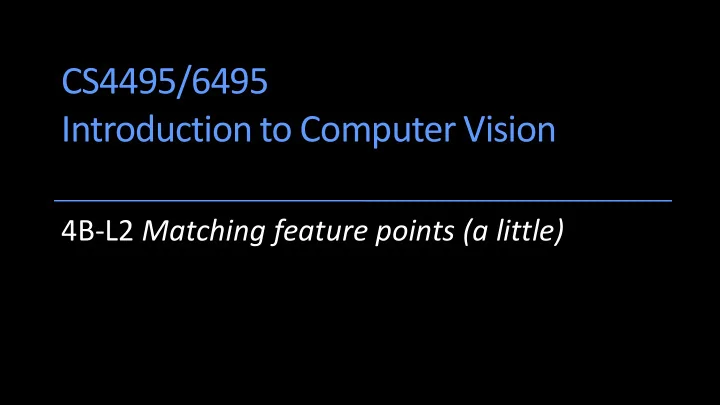

CS4495/6495 Introduction to Computer Vision 4B-L2 Matching feature points (a little)
Feature Points • We know how to detect points
Feature Points • We know how to describe them
Feature Points • Next question: How to match them? ?
How to match feature points? • Could just do nearest-neighbor search − [OMS students: You will!] • But that’s really expensive…SIFT tests have 10,000 ’s of points!
Nearest-neighbor matching to feature database • Better: Hypotheses are generated by approximate nearest neighbor matching of each feature to vectors in the database • SIFT uses best-bin-first (Beis & Lowe, 97) modification to k-d tree algorithm • Use heap data structure to identify bins in order by their distance from query point
Nearest-neighbor matching to feature database • Result : Can give speedup by factor of 100-1000 while finding nearest neighbor (of interest) 95% of the time
Nearest neighbor techniques • k -D tree and • Best Bin First (BBF) Indexing Without Invariants in 3D Object Recognition, Beis and Lowe, PAMI’99
Wavelet-based hashing Compute a short (3-vector) descriptor from the neightborhood using a Haar “wavelet” [Brown, Szeliski , Winder, CVPR’2005 ]
Wavelet-based hashing Quantize each value into 10 (overlapping) bins (10 3 total entries) [Brown, Szeliski , Winder, CVPR’2005 ]
Locality sensitive hashing Kulis & Grauman, “ Kernelized Locality-Sensitive Hashing for Scalable Image Search” ICCV , 2009.
3D Object Recognition Train: 1. Extract outlines with background subtraction 2. Compute “ keypoints ” – interest points and descriptors.
3D Object Recognition Test: 1. Find possible matches. 2. Search for consistent solution – such as affine . (How many points?!?!?)
Results
Recognition under occlusion
Recognition under occlusion
Locating object pieces (From last lesson)
SIFT in Sony Aibo (Evolution Robotics) SIFT usage: • Recognize charging station • Communicate with visual cards
Recommend
More recommend